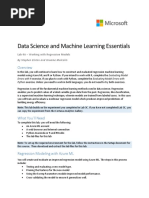0 ratings0% found this document useful (0 votes)
55 viewsSampling & Non Sampling Error
Uploaded by
surender paulCopyright
© © All Rights Reserved
Available Formats
Download as PDF, TXT or read online on Scribd
0 ratings0% found this document useful (0 votes)
55 viewsSampling & Non Sampling Error
Uploaded by
surender paulCopyright
© © All Rights Reserved
Available Formats
Download as PDF, TXT or read online on Scribd
You are on page 1/ 12
Dr.D.Y.
Patil Unitech Society's
Dr.D.Y.Patil Arts, Commerce &
Science College,
Pimpri, Pune - 18.
Name:Asst.Prof Komal Kothawade
Department:Statistics
SAMPLING AND NON-
SAMPLING ERRORS
DEFINITIONS
Sampling: The process of selecting a part of the population.
Population: The entire group of people of interest from whom
the researcher needs to obtain information.
Sample: A selected part of the population is called sample. It
should be true representative of the whole population.
Sample size: The number of people in the selected sample is
known as sample size.
Statistics: Any value calculated from sample is called statistics.
Parameter: Any value calculated from population is called
parameter.
Sampling frame: A list or map identified each sampling unit by
a number belonging to population under study is called
sampling frame.
Sampling technique: It refers to technique or procedure used
to select the members of the sample.
ERRORS IN SAMPLING
ERRORS: Statistical error is the difference between a value
obtained from a data collection process and the true value for
the population.
Data can be affected by two types of error:
1. Sampling Error
2. Non-Sampling Error
Sampling Errors: Is one which occurs due to
UNREPRESENTATIVENESS OF THE SAMPLE selected for
observation.
Non-Sampling Errors: Is an error arise from HUMAN ERROR
such as errors in PROBLRM IDENTIFICATION, METHODS, or
PROCEDURES USED etc.
SAMPLING ERROR
“Sampling error is the error that arises in a
data collection process as a result of taking a
sample from a population rather than using the
whole population”.
Even after taking care in selecting sample, there may be chances
that true value is not equal to the observed value because estimation
is based on the part of the population not on the whole. Hence
sampling give rise to certain errors known as SAMPLING ERRORS.
TYPES OF SAMPLING ERRORS
Biased Sampling Error:
When the selection of sample is based on the personal prejudice or
bias of the investigator then the results are prone to bias errors. Such
as, if the investigator is required to collect the sample using the simple
random sampling and instead he used the non-random sampling,
then personal prejudice is introduced in the research process that will
lead to the biased errors.
Unbiased Sampling Error:
The Unbiased Errors arise due to a chance, i.e. the investigator has
not intentionally tampered with the sample and that the difference
between the population and sample have occurred by chance.
These errors arise due to chance differences between the members of
population included in the sample and those not included.
Reasons of Sampling Error
• Faulty selection of sampling method.
• Faulty demarcation of sampling units.
• Variability of the population which has different characteristic.
• Substituting one sample for other sample due to difficulties in
collecting the sample.
Here are the steps for minimizing Sampling Error
• You can simply increase the sample size. A larger sample
size generally leads to a more precise result because the
study gets closer to actual population size and the results
are obtained are more accurate.
• Dividing the population into groups.
• Random selection results in the elimination of bias.
• Performing an external record check.
NON-SAMPLING ERROR
Non-Sampling Error is an error arise from human error, such as
error in problem identification, method or procedure used etc.
“Non-Sampling Error is the error that arises in a
data collection process as a result of factors other
than taking a sample”.
Types:
RESPONSE ERROR
RESPONDENT ERROR
INTERVIEWER ERROR
Response Error
Response errors represent lack of accuracy in responses
to questions. They can be attributed to different factors,
including a questionnaire that requires improvement,
misinterpretation of questions by interviewers or
respondent, and errors in respondents statements.
Response bias causes survey participants to answer
inaccurately, which skews data and makes meaningful
analysis difficult for your business.
Factors in sampling method influence
the data obtained.
EXAMPLE: A respondent may answer
questions in the way she thinks the questioner wants her
to answer or a man may respond differently to a woman
when asked questions about domestic violence.
NON- SAMPLING ERRORS ARISES DUE TO
FOLLOWING REASONS
• Lack of trained and qualified investigators.
• Due to wrong answers to the questions.
• Due to incomplete coverage.
• Biasness of the investigators.
• Vague questionnaire.
• Faulty list of population.
• Wrong method of asking questions.
• Wrong calculations while processing the data.
• Failure of respondent memory to recall past events.
Steps for minimizing Non-Sampling Error
• Randomize selection to eliminate bias.
• Train your team
• Perform an external record check.
BASIS FOR SAMPLING NON-SAMPLING
COMPARISION ERROR ERROR
Meaning Sampling error is a An error occurs due to
type of error, occurs sources other than
due to sample selected sampling, while
does not perfectly conducting survey
represents the activities is known as
population of interest. Non-Sampling Error.
Cause Deviation between Deficiency and analysis
sample mean and of data.
population mean.
Occurs Only when sample is Both in sample and
selected. census.
Sample size Possibility of error It has nothing to do
reduced with the with the sample size.
increase in sample
size.
THANK YOU!
Presentation by-
KAJAL. S. PATIL
You might also like
- (Latest Edited) Full Note Sta404 - 01042022No ratings yet(Latest Edited) Full Note Sta404 - 01042022108 pages
- Hypothesis Testing: An Intuitive Guide for Making Data Driven DecisionsFrom EverandHypothesis Testing: An Intuitive Guide for Making Data Driven DecisionsNo ratings yet
- Outline of Presentation: Sample Sampling Sampling Method Types of Sampling Method Sampling ErrorNo ratings yetOutline of Presentation: Sample Sampling Sampling Method Types of Sampling Method Sampling Error25 pages
- Sampling: Sampling Is Part of Daily LifeNo ratings yetSampling: Sampling Is Part of Daily Life13 pages
- Sampling Error- Definition, Types, + How to Reduce ErrorsNo ratings yetSampling Error- Definition, Types, + How to Reduce Errors9 pages
- NON Sampling Error Definition A Statistical Error Caused by Human Error ToNo ratings yetNON Sampling Error Definition A Statistical Error Caused by Human Error To4 pages
- Samplingandnon Samplingerror 221019145156 34a4b601No ratings yetSamplingandnon Samplingerror 221019145156 34a4b60118 pages
- Sampling and Non Sampling Error and QuestionnaireNo ratings yetSampling and Non Sampling Error and Questionnaire34 pages
- Research Methods and Sampling Design: (Document Subtitle)No ratings yetResearch Methods and Sampling Design: (Document Subtitle)11 pages
- 6.controlling Sampling Non-Sampling ErrorsNo ratings yet6.controlling Sampling Non-Sampling Errors3 pages
- STAT 366 - Sample Survey Theory and Methods II - Lecture 1No ratings yetSTAT 366 - Sample Survey Theory and Methods II - Lecture 123 pages
- Types of Errors Affecting Research DesignNo ratings yetTypes of Errors Affecting Research Design14 pages
- Q2 Module 2 - Sample and Sampling TechniquesNo ratings yetQ2 Module 2 - Sample and Sampling Techniques8 pages
- Capability Analysis (Normal) Formulas - Benchmark Z'S: Technical Support DocumentNo ratings yetCapability Analysis (Normal) Formulas - Benchmark Z'S: Technical Support Document6 pages
- TRIAL STPM Mathematics M 2 (NSEMBILAN) SMK TgDurahSerembanNo ratings yetTRIAL STPM Mathematics M 2 (NSEMBILAN) SMK TgDurahSeremban14 pages
- Multivariate Analysis: Library (Rethinking Data (Hurricanes) ?hurricanes. Deaths Femininity Femininity DeathsNo ratings yetMultivariate Analysis: Library (Rethinking Data (Hurricanes) ?hurricanes. Deaths Femininity Femininity Deaths2 pages
- Data Science and Machine Learning Essentials: Lab 4A - Working With Regression ModelsNo ratings yetData Science and Machine Learning Essentials: Lab 4A - Working With Regression Models24 pages
- End-Term Examination: Indian Instituteofmanagementkozhikode Executive Post Graduate ProgrammesNo ratings yetEnd-Term Examination: Indian Instituteofmanagementkozhikode Executive Post Graduate Programmes3 pages
- Chapter 7 - Control Techniques in Experimental ResearchNo ratings yetChapter 7 - Control Techniques in Experimental Research40 pages
- BA - ASSIGNMENT - Shyam Sunder Singh - GROUP 2No ratings yetBA - ASSIGNMENT - Shyam Sunder Singh - GROUP 225 pages
- Hypothesis Testing: An Intuitive Guide for Making Data Driven DecisionsFrom EverandHypothesis Testing: An Intuitive Guide for Making Data Driven Decisions
- Outline of Presentation: Sample Sampling Sampling Method Types of Sampling Method Sampling ErrorOutline of Presentation: Sample Sampling Sampling Method Types of Sampling Method Sampling Error
- Sampling Error- Definition, Types, + How to Reduce ErrorsSampling Error- Definition, Types, + How to Reduce Errors
- NON Sampling Error Definition A Statistical Error Caused by Human Error ToNON Sampling Error Definition A Statistical Error Caused by Human Error To
- Samplingandnon Samplingerror 221019145156 34a4b601Samplingandnon Samplingerror 221019145156 34a4b601
- Research Methods and Sampling Design: (Document Subtitle)Research Methods and Sampling Design: (Document Subtitle)
- STAT 366 - Sample Survey Theory and Methods II - Lecture 1STAT 366 - Sample Survey Theory and Methods II - Lecture 1
- Applied Survey Methods: A Statistical PerspectiveFrom EverandApplied Survey Methods: A Statistical Perspective
- Capability Analysis (Normal) Formulas - Benchmark Z'S: Technical Support DocumentCapability Analysis (Normal) Formulas - Benchmark Z'S: Technical Support Document
- TRIAL STPM Mathematics M 2 (NSEMBILAN) SMK TgDurahSerembanTRIAL STPM Mathematics M 2 (NSEMBILAN) SMK TgDurahSeremban
- Multivariate Analysis: Library (Rethinking Data (Hurricanes) ?hurricanes. Deaths Femininity Femininity DeathsMultivariate Analysis: Library (Rethinking Data (Hurricanes) ?hurricanes. Deaths Femininity Femininity Deaths
- Data Science and Machine Learning Essentials: Lab 4A - Working With Regression ModelsData Science and Machine Learning Essentials: Lab 4A - Working With Regression Models
- End-Term Examination: Indian Instituteofmanagementkozhikode Executive Post Graduate ProgrammesEnd-Term Examination: Indian Instituteofmanagementkozhikode Executive Post Graduate Programmes
- Chapter 7 - Control Techniques in Experimental ResearchChapter 7 - Control Techniques in Experimental Research

























































































